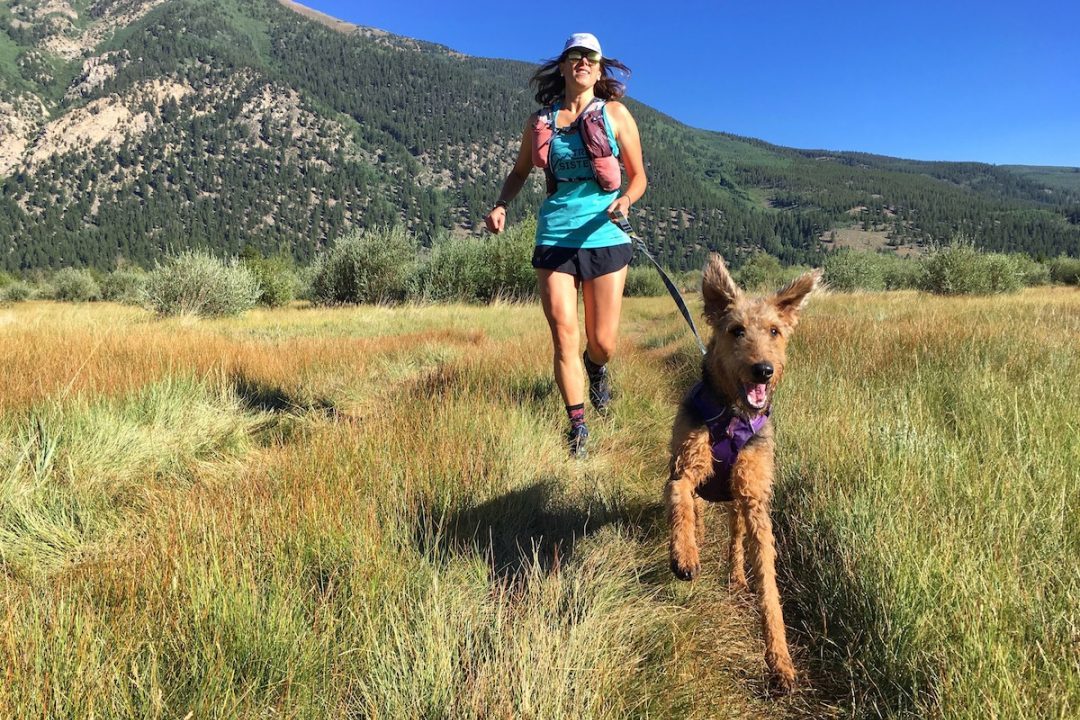Main Menu

How much is too much when running with your dog?
I’ve been running with my boyfriends dog for the past few years + since he’s aging I’m really noticing a difference in his endurance. I keep an eye on him + turn around *before* he starts showing signs of fatigue because as a dog he just wants to keep going + keep up with him. Big signs of his fatigue include me keeping up with him [or him staying behind me], him immediately laying down if I stop for any reason + him happily slowing to a walk next to me on uphills. I’ll also pay close attention to how much water he is drinking — if he’s gulping down water I know it’s time to head home. Another indicator is how he acts the next day — if he’s legit pooped a day or two later, whatever distance we just ran becomes our ‘extra long day’ limit.
I love this question! I was a vet tech in a former life, and then a research assistant in physiology (now I teach English Literature, because of reasons and things). Some things to keep in mind before “too much” is even an issue: dogs release heat through their paws, and via panting. Both of these are small avenues. Add to this that they are receiving heat from the ground at closer proximity, and over more surface area, than a human. Then, add the fact that their paw pads are hairless, and therefore susceptible to burns from hot ground. To combat these issues, try to allow dogs to run on cooler surfaces (grass instead of asphalt), in shady areas, and early mornings in hotter areas. Check paw pads after each run for burns, blisters, or damaged areas.
Try to plan routes that have water for your pet to get IN, not just drink. A good dip will do them well. Gums should remain pink, but not red. This one is kinda gross, but their slobber should have a consistency similar to resting. Thicker slobber is a sign of over-heating and dehydration. Keep your dog’s anatomy in mind also. Brachiocephalic breeds should not run long distances, or in warmer weather. They simply cannot release heat well enough.
Now, aside from heat, miles matter. NO DOG under 6 months old should run more than a few miles (this is a literal few, not an ultrarunner few). Larger breeds should wait a full year. As your dog is growing, talk to your vet about your plans. The vet will keep an extra eye on how the dog’s joints are developing.
Now, for an unpopular opinion: In long distance running, it’s safer FOR THE DOG to be off leash. This allows the dog to manage its own tempo, stop at a creek for a drink or splash, dart from shady spot to shady spot. Being off-leash should be left to responsible pets and pet-owners in areas that allow for this. Check leash laws, and remember, your dog does not have the same rights as a human on the trail. Sorry. Not everyone loves your dog, nor do they have to. SO, if a leash is a must (and often times it is), be VERY aware of what your dog is wanting/needing. It may slow your run, and require you to stop at every stream, puddle, shade tree on the way. Do it. You’re responsible for that dog’s life, and the safety of the other humans around you. Phew, that was long. Sorry.
I used to have a dog that I ran with, and I always had to be careful because she was SO loyal that she would’ve literally followed me until she dropped. The first thing is to make sure they can handle the endurance side of things, so keep an eye on heavy panting and signs of exhaustion. The second thing is making sure they can handle the wear and tear. I would say the key is to build up slowly and consult with a vet.
A dog won’t tell us, so I keep her running miles between 5-10 daily with maybe one 15-20 miler a month and it seems to be a good approach for my mini – Australian Shepard. Like us, fueling is a big part of being able to manage miles, so an extra helping of food, and not being stingy on treats when we are running regularly seems to be a good strategy. Doggy-massage, good naps and lots of cuddles go a long way too.
Dogs will often continue running through pain and fatigue just to accompany you so it’s up to you to give’em a break or just go for a casual sniffing jog. Dogs are like us, they need plenty of rest, a healthy calories, and a gradual ramp up to build endurance. Unlike us, however, they can’t sweat, so be extra careful not to overdo it when it’s toasty outside. Plan hot weather runs around shady paths, lakes and streams and keep the pace relaxed.
There is nothing like the sight of my trail shoes and running vest to get my dog’s tail-less rump vibrating at a million RPMs! He always wants to go; lab brains know no limits. During runs, I pack extra water, and plan routes that cross rivers and lakes so that we can both cool off and drink. Kodiak ensures that I take breaks and fully immerse myself in my surroundings!
To help keep my pup healthy and to make sure that he has plenty of time to recover, I tend to hold to a few guidelines: I keep his runs at 20 miles or less; I avoid back-to-back runs of 10 miles or more; I take him for a “recovery” walk after a longer trail run so I can observe his gait and make sure that he isn’t gimpy in any way; and I check his pads for wear and tear. If anything is off, I make sure he has some extra days to rest—sometimes that leads to some sad eyes staring after me as I head to the trails, but I know it is best for him.







